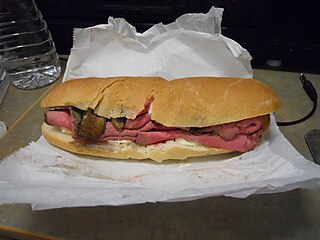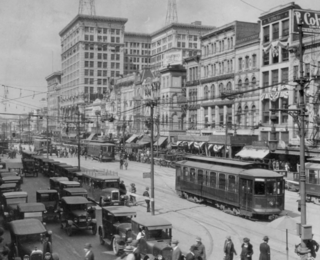
Cajun cuisine is a style of cooking developed by the Cajun–Acadians who were deported from Acadia to Louisiana during the 18th century and who incorporated West African, French and Spanish cooking techniques into their original cuisine.

Louisiana Creole cuisine is a style of cooking originating in Louisiana, United States, which blends West African, French, Spanish, and Native American influences, as well as influences from the general cuisine of the Southern United States.

In Vietnamese cuisine, bánh mì or banh mi is a short baguette with thin, crisp crust and a soft, airy texture. It is often split lengthwise and filled with meat and savory ingredients like a submarine sandwich and served as a meal, called bánh mì thịt. Plain bánh mì is also eaten as a staple food.

Rémoulade is a cold sauce. Although similar to tartar sauce, it is often more yellowish, sometimes flavored with curry, and often contains chopped pickles or piccalilli. It can also contain horseradish, paprika, anchovies, capers and a host of other items.
Sandwiches That You Will Like is a 2002 PBS documentary by Rick Sebak of WQED. The unique sandwich offerings of cities across the United States are shown, from those that are often found outside of their city of origin to the virtually unknown.
A pistolette is either of two bread-based dishes in Louisiana cuisine. One is a fried bread roll, that can also be stuffed, in the Cajun areas around Lafayette and Lake Charles. The other is a type of submarine shaped bread about half the size of a baguette that is popular in New Orleans for Vietnamese bánh mì and other sandwiches. In France and Belgium, the word pistolet refers to a round roll.

The roast beef sandwich is a sandwich that is made out of sliced roast beef or sometimes beef loaf. It is sold at many diners in the United States, as well as fast food chains, such as Arby's, Rax Roast Beef, and Roy Rogers Restaurants. This style of sandwich often comes on a hamburger bun and may be topped with barbecue sauce and/or melted American cheese. The roast beef sandwich also commonly comprises bread, cold roast beef, lettuce, tomatoes, and mustard, although it would not be uncommon to find cheese, horseradish, fresh/powdered chili pepper and even in some cases red onion. Roast beef sandwiches may be served hot or cold, and are sometimes served open faced.

Regional street food is street food that has commonalities within a region or culture.

This article discusses the various cuisines in Houston, Texas.

Dong Phuong Oriental Bakery is a Vietnamese retail and wholesale bakery, restaurant, and catering business in New Orleans, Louisiana. It is known for supplying the baguette style bread for many of the city's restaurants that offer banh mi or other sandwiches, and has its own popular banh mi counter. The bakery, along with the nearby Mary Queen of Vietnam Catholic Church, were fixtures of the Vietnamese community in New Orleans even before surviving the devastation of Hurricane Katrina. It is located at 14207 Chef Menteur Highway in the "Little Vietnam" section of Eastern New Orleans. It is attached to a sit-down restaurant of the same name that serves a variety of Vietnamese and Chinese dishes, including phở, bún thịt nướng, bún riêu, and bánh hỏi.

The cuisine of New Orleans encompasses common dishes and foods in New Orleans, Louisiana. It is perhaps the most distinctively recognized regional cuisine in the United States. Some of the dishes originated in New Orleans, while others are common and popular in the city and surrounding areas, such as the Mississippi River Delta and southern Louisiana. The cuisine of New Orleans is heavily influenced by Creole cuisine, Cajun cuisine, and soul food. Later on, due to immigration, Italian cuisine and Sicilian cuisine also has some influence on the cuisine of New Orleans. Seafood also plays a prominent part in the cuisine. Dishes invented in New Orleans include po' boy and muffuletta sandwiches, oysters Rockefeller and oysters Bienville, pompano en papillote, and bananas Foster, among others.

Domilise's Po-Boy and Bar is an uptown New Orleans restaurant known for its po-boy sandwiches. The restaurant was founded in the 1930s by the Domilise family, who lived in the house above the single-room bar/dining area, and was run by Sam and Dorothy “Miss Dot” Domilise for over seventy-five years until her death in 2013. The restaurant was closed during 2005's Hurricane Katrina while the family evacuated to Alabama and to Franklin, Louisiana.

The Parish was a Cajun, Louisiana Creole, and seafood restaurant in Portland, Oregon's Pearl District, in the United States. It was opened by Tobias Hogan and Ethan Powell in 2012, and became known for its oysters. In 2015, the restaurant was split in half, and one side of the space began serving brunch, lunch, and happy hour as the Palmetto Cafe. The Palmetto was converted into a private event space and pop-up restaurant in February 2016, and The Parish closed abruptly in September of that year.

Antone's Famous Po' Boys, formerly Antone's Import Company, is a sandwich shop chain based in Houston, Texas. Established by Jalal Antone, an American of Lebanese and Syrian descent, it grew to having fifteen locations and having products distributed throughout the Southern United States, but was beset by ownership disputes within the surviving family in the 1990s. Legacy Restaurants now owns the trademark and operates all restaurants with the name. From circa the 1990s until 2018 several shops franchising the Antone's name were operated as the Original Antone's Import Company.

The 1929 New Orleans streetcar strike was a labor dispute between streetcar workers and the New Orleans Public Service, Inc. (NOPSI). Involving 1,100 workers, it began on July 1, 1929, and lasted over four months. It is credited with the creation of the po' boy sandwich. At one point a streetcar was burned by strikers.

New Orleans hot sausage is a type of sausage used in Cajun and Louisiana Creole cuisine.














